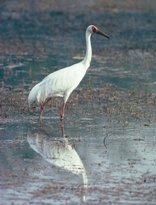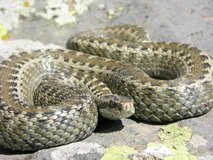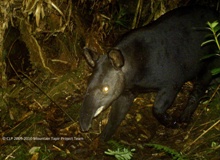Team Awards are granted to teams of three or more individuals who are undertaking high-priority conservation projects. The awards are arranged in a tiered system to allow for progression and include the Future Conservationist Award, Conservation Follow-up Award and Conservation Leadership Award.
ASIA/PACIFIC
 Habitat Requirements and Management for Siberian Cranes at Momoge, China (2010)
Habitat Requirements and Management for Siberian Cranes at Momoge, China (2010)
The Siberian Crane is ranked as a critically endangered species by the IUCN Red list. Every year, they need to fly thousands of kilometres from their breeding site to wintering sites. The peak number of migratory Siberian Cranes reached 3133 birds at Momoge wetland in the spring season of 2010, which accounts for over 95% of the world population of Siberian Cranes. Now, the Momoge wetland has became the largest stopover site of Siberian Crane in the world.
Small Carnivore Conservation in the Mekong Delta, Vietnam (2006)
For the past two months the field team of the Carnivore and Pangolin Conservation Program (CPCP), has been busy surveying for small carnivores and pangolins in the U Minh wetlands, South Vietnam. The teams most recent survey work has taken them into the unprotected Fishery and Forestry Enterprises. This area of wetland forest, roughly 30,000 hectares in size, lies right between two of Vietnams most important protected areas; U Minh Ha National Park in the South and U Minh Thuong National Park in the North, both of which hold important populations of Sunda pangolin (Manis javanica) as well as the very rare and endangered hairy-nosed otter (Lutra sumatrana).
Bengal Florican Conservation and Research Initiative in BTAD, India (2008)
The landscape in and around the exotic Manas National Park is one of the most resourceful. The poverty compels these people to bank heavily on forest resources found in Manas Park for their livelihood which is found detrimental to conservation initiatives in the Park. In order to show the way for an alternative livelihood option not dependent of forest resources, Aaranyak came up with an idea of introducing the concept of food processing and preservation as alternative livelihood especially among the women folk of the area. The basic objective is to promote food processing using fruits and vegetables grown in the area.
Bat Count Philippines (2003, 2006)
During the end of the month of October the Buglasan Festival of Festivals was held in the City of Dumaguete and featured once again the Bat Festival. This festival came about with the support of the Bat Count Philippines team and they continue to play a critical role in its development.
Read more about projects in Asia/Pacific...
EURASIA
Conservation and Research of Distribution of the Critically Endangered Darevsky's viper (Vipera darevskii) in Armenia (2005, 2007)
 Intensive field surveys have shown that the endemic and critically endangered Darevsky's viper has an extremely limited range of only (250 ha) in subalpine and alpine meadows of Armenia at 2300-3000 m above sea level. In addition to local awareness-raising through a documentary, brochures and booklets, viper conservation measures included the construction of watering sites (troughs) for livestock and the fencing of some habitat patches.
Intensive field surveys have shown that the endemic and critically endangered Darevsky's viper has an extremely limited range of only (250 ha) in subalpine and alpine meadows of Armenia at 2300-3000 m above sea level. In addition to local awareness-raising through a documentary, brochures and booklets, viper conservation measures included the construction of watering sites (troughs) for livestock and the fencing of some habitat patches.
Survey of 3 Potential Important Bird Areas in Collaboration with Students in Uzbekistan (2010)
A survey of Akpetky lake system and Sarykamysh Lake was carried out in the northern part of Uzbekistan from 15th October to 3rd November 2010. The main goal of the survey was to collect materials from these little studied territories for IBA description and propose them for IBA nomination.
Community-based Conservation of Lake Kuyucuk Ramsar Site, Turkey (2008, 2010)
Two flamingos (Phoenicopterus roseus) were photographed last week by the science coordinator of KuzeyDoga Society, Emrah Coban at the Ramsar site of Lake Kuyucuk Wildlife Reserve. These birds prefer warm to tropical climates and breed in warm regions of Turkey, so it was a surprise to see them in the winter in Kars, which has a Siberia-influenced weather similar to those of Russia, Montana or even Alaska.
Conservation of White-headed duck (Oxyura leucocephala) in Russian Federation. (2006, 2008, 2010)
The project team carried out the educational campaign among the local population of two regions of Western Siberia during June-September. The objective of the campaign was to raise the level of understanding of the significance of the conservation of the White-headed duck (Oxyura leucocephala) and places of its habitat.
Read more about projects in Eurasia...
LATIN AMERICA
 Abundance of Mountain Tapir in Puracé National Park, Colombia (2009)
Abundance of Mountain Tapir in Puracé National Park, Colombia (2009)
After many months of surveying in Purace National Park with no pictures of tapirs, the team moved to Cusiyaco lagoon close to Hoyola cab in the south of the protected area, where to date they have recorded 27 pictures of Mountain Tapir and additional fauna such as Tapeti (Sylvilagus brasiliensis), Spectacled Bear (Tremarctos ornatus) VU, Northern Pudu and White-nosed Coati.
Project Chicamocha II: Saving the Threatened Dry Forest Biodiversity (2004, 2008)
In September 2010 Project Chicamocha received recognition for its great job in project monitoring and evaluation methodology by Eco-Index , a database managed by the Rainforest Alliance that includes profiles of over 1000 projects in the Americas.
Araripe Manakin Conservation Center, Brazil (2004, 2007, 2010)
Seven members of the Aquasis Bird Conservation Team convened the last week of October, 2010 in the city of Crato, located at the base of the Chapada do Araripe in the extreme south of the northeastern Brazilian state of Ceará, to pursue ongoing efforts to map the distribution of one of the worlds most critically endangered bird species, the Araripe Manakin (Antilophia bokermanni). The goal was simple, visit each of the 128 currently known sources of spring water on the slopes of the Araripe Plateau to update and verify GPS coordinates and determine the presence or absence of the species at each locality.
Participative Research on Biodiversity (R.O.B.IN) in Uruguayan Artisanal Red Shrimp Fishery (2010)
ROBIN Uruguay is a project which aims to evaluate together with artisanal fishermen the efficiency of a by-catch reduction device implemented in a trawling shrimp-net. A puppet show on artisanal fisheries and conservation of marine biodiversity was presented by Scholars from Barra de Valizas on Friday 10th December, which provided an opportunity to link artisanal fishermen, local community and diversity issues.
Read more about projects in Latin America...

